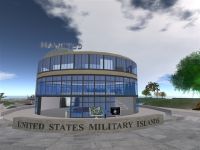WASHINGTON, May 9, 2011 — Five years from now, if Frank C. DiGiovanni has his way, warfighters from every service will learn aspects of their trade on a world in cyberspace.
The Defense Department will save money, time, and ultimately, lives, he said, and it’s his job to make that virtual world a reality.
DiGiovanni is director of training readiness and strategy in the office of the deputy assistant secretary of defense for readiness. He’s also a retired Air Force colonel and a senior aviator.
“I’d love to see it happen in the next 18 months to two years,” DiGiovanni said in an interview with American Forces Press Service. “Realistically, a full-up world is probably five years away.”
Over the next five years, the Defense Department will build that world in cyberspace, where the men and women of the armed forces will take another step forward in the transition from analog to digital technology that began with the public Internet and DOD websites.
A virtual world is a computer-based simulated environment that’s available 24 hours a day. Users create digital representations of themselves, called “avatars,” that build out the world, creating content and communicating with each other.
Second Life is one of many virtual worlds that exist in cyberspace. It opened in 2003, created by Linden Lab, a San Francisco-based company founded in 1999 by Philip Rosedale to create a new form of shared experience.
Second Life residents — 20 million and rising, from hundreds of countries — build and own the world’s digital infrastructure. This includes homes, vehicles, campuses of real-life universities, museums, nightclubs, stores, libraries, landscapes, games, islands, companies, government organizations and military bases.
A handful of U.S. government agencies have facilities of varying complexity and interaction in Second Life.
These include NASA, the National Oceanic and Atmospheric Administration, the National Institutes of Health and its National Library of Medicine, the Centers for Disease Control and Prevention, the Department of Homeland Security, the House of Representatives and more every day.
The Defense Department’s virtual world may be five years away, but the Army, Navy and Air Force all have public and private facilities in Second Life, and in other virtual worlds, including Teleplace and OpenSimulator.
In Second Life, U.S. military activities take place on a growing collection of islands called “Military Islands.”
MiLands was established in 2008 by Doug Maxwell, formerly of the Naval Undersea Warfare Center and now science and technology manager for virtual world and strategic applications at the Army Simulation and Training Technology Center in Orlando, Fla. MiLands includes the Air Force Air Education and Training Command and Air University, the Naval Undersea Warfare Command and other Navy projects, a Marine Corps island, several Army groups and Coalition Island, a military hub.
Each group uses Second Life for activities that include training, education, collaboration and research.
DiGiovanni praises these efforts as “pioneering work done by the services and some people with great vision who really saw the potential” of virtual worlds for military uses. “But we felt it was ad hoc,” DiGiovanni said.
For the DOD virtual world experts are working on “a governance model that makes sense” in which everyone in the world can participate, DiGiovanni said, much like the Constitution allows American citizens to participate in their government.
“A governance model allows you to take all the efforts that are going on and synchronize them, integrate them, so you have a comprehensive whole, and not four separate efforts,” he added.
“I don’t want four separate worlds, I want one world … to be able to leverage all that content building that’s being done by everyone out there,” the director said.
DiGiovanni began thinking about emerging technologies when he was asked to develop a training environment that was available globally, 24 hours a day, seven days a week. Some of the inspiration for virtual world military training came from massively multiplayer online games, such as Halo and Call of Duty, he said.
“When you look at the ability to go to an online game, pick a team ad hoc, decide on the tactic and then start the game,” DiGiovanni added, “that’s when you think, if we can do that in the commercial world, the Defense Department needs a similar capability.”
A “perfect storm” of resource constraints, global repositioning of troops coming home from the Middle East, and competing demands for land, air and maritime training capability makes it critical to develop a virtual training capability, he said.
Such an environment, DiGiovanni said, must be “augmented with some type of physical training to make sure that what you’re learning in the virtual world can be exported to the real world.”
Virtual training can be very effective, he added, and can help people become much more proficient in the limited amount of time and space available with live resources. The Strategic Plan for the Next Generation of Training for the Department of Defense, published in 2010, DiGiovanni said, discusses “leveraging emerging technologies to enhance our training capabilities.”
The plan was fully vetted across all four services and signed by Deputy Defense Secretary William J. Lynn III, he added. Essential features of a technology-based training environment, the report says, include synchronizing “live and virtual training operations in near-real time to enable realistic simulation of sensors, replication of visual cues and platform interactions [among] live, virtual and constructive participants.”
DiGiovanni and his staff meet with industry experts and consult regularly with the technological pioneers who are building virtual capacity today for the military services. Carl Rosengrant, senior technical adviser for training readiness and strategy, said his office would soon receive the results of a study by industry experts to help DOD define the framework and tools needed to develop the Defense Department online world.
When the report is written and vetted with technology experts in the military services, DiGiovanni said, “We think we’ll be able to put the construct together that would allow us to build a world.”
American culture is well postured to lead a revolution in the use of the virtual training environment, DiGiovanni said.
“I challenge everyone to put their pioneering spirit on,” he said, “think about where technology can take us, and then let’s go there together.”
Source:
U.S. Department of Defense
Office of the Assistant Secretary of Defense (Public Affairs)

 von
von 
